Tony Eldridge's Blog, page 5
September 1, 2013
How to Edit your Book - Method 1: Friends, Family, and Coworkers
This chapter explains how to transform your self-edited manuscript into a finished manuscript. A high-quality book requires extensive testing and copyediting. You can get these processes done without a traditional publisher, but you cannot eliminate them. Your goal is a book that looks and feels as good as any book from a big-time, traditional publisher.
Publishing a book, whether a traditional publisher does it or you do it yourself, requires two kinds of editing. First, content editing helps you make your book more appealing by changing the organization, structure, content, and style of your manuscript. Second, copyediting is what turns an amateurish book into a polished, professional one.

The self-edited author is as foolish as the self-medicated patient. In Let's Get Digital, http://www.amazon.com/Lets-Get-Digital-Self-Publish-ebook/dp/B005DC68NI, David Gaughran provides an example of how Esquire editor Gordon Lish edited Raymond Carver's short story "What We Talk About When We Talk About Love."
Lish's editing marks on the original version shows how much value a content editor can add: http://www.newyorker.com/online/2007/12/24/071224on_onlineonly_carver.
If you think you're the first author in the history of mankind who doesn't need a copyeditor, keep two examples in mind: First, in 2010, Penguin Australia published a book called The Pasta Bible. The recipe for tagliatelle called for "salt and freshly ground black people." Penguin had to destroy seven thousand copies because of this gaffe although sales of the book quadrupled because of the publicity.
Second, every time I turn in the "final" copy of a book, I believe that it's perfect.
In APE's case, upward of seventy-five people reviewed the manuscript, and Shawn and I read it until we were sick of it. Take a wild guess at how many errors our copyeditor found. The answer is 1,500. You read that right: one thousand five hundred, and you may still find some, because we went right to publishing after copyediting even though traditional publishers proofread a book twice after copyediting. If you see any errors, please send me an email at Guy@Alltop.com.
You're going to read this again and again in APE: you cannot eliminate the need for a copyeditor. There are four methods to obtain both kinds of editing: enlisting friends, family, and coworkers; tapping niche communities; crowdsourcing; and hiring professionals. I do all four for every book! You can never get too much editing and feedback.
I send the first complete draft of my manuscripts to an inner sanctum of five to ten people. I've known them for years and trust their judgment. I want them to act like "book murderers," a term Michael Alvear coined in his book Make a Killing on Kindle, http://www.amazon.com/Blogging-Facebook-Guerilla-Marketers-ebook/dp/B007XVWEIU
If you're starting your writing career, you may not have a cadre of friends, family, and coworkers to murder your book, but you must respect some people. Now is the time to tap these relationships.
Shawn is decades younger than me, and he's on his fourth book. His family and friends are not interested in reading an iOS development book, so he asks for volunteer readers when speaking at conferences. Each volunteer receives a "beta version" of chapters as well as the final book as a PDF a few weeks before its public release.
Shawn's method illustrates an important concept: If you don't ask, you don't get. I push this concept to the edge. For example, I noticed that Kristen Eckstein left insightful and helpful comments on my Google+ posts about publishing, so I contacted her to see if she'd like to read the manuscript of APE.
She agreed, and she returned the manuscript with 254 insertions, 165 deletions, 30 format changes, and 275 comments. I used 90 percent of them. From now on, she's on the friends and family list for my future books.
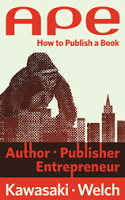
Guy Kawasaki has written 12 books, 10 of which were traditionally published. His newest book is APE: Author, Publisher, Entrepreneur - How to Publish a Book, which helps people understand how and why to self-publish.
APE: Author, Publisher, Entrepreneur - How to Publish a Book, by Guy Kawasaki and Shawn Welch, is available as an eBook ($9.99) and in paperback ($24.99). Visit http://apethebook.com/








Published on September 01, 2013 19:40
August 29, 2013
The Ultimate Guide to Marketing Your Books Through Guest Blogging
Regardless of what you sell, guest
blogging is still one of the best internet marketing methods that you can
implement to further your goals.
The thing is, unlike any other
type of marketing methods, guest posting is pretty well rounded as far as
building brand recognition (and reputation), helping you rank in the SERPs, and
getting massive traffic to your site.
Considering the strategic
advantage you can get from guest blogging, allow me to share with you a guide
to help you with it. This guide will be your A – Z guide. It’s a literal walk
through on what you need to do to land the links and the relationships.
Without further adieu, here’s
step one of the process.
1.) You need to look for niche related sites
that you can link to
To do this, you simply need to
type in your niche and “guest post” on Google’s search engine.
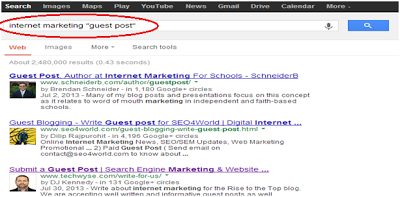
The significance of adding the quotation mark (“”) on the
word guest post is to tell Google that you are looking for the exact same
results.
The results you’re seeing now are sites related to internet
marketing (the example niche) that accepts guest post.
There are other advanced queries that you can use for
searching which I’ll share with you later.
2.) Download the Google scraper similar app
(this is free) by going to the chrome web store. Right click on one of the
links then click the scrape similar icon.
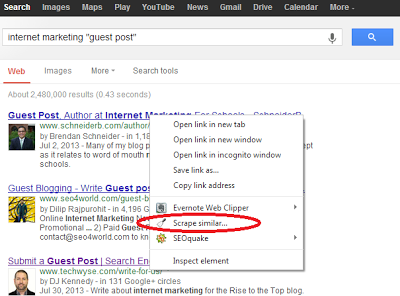
Hint: You need to
change the number of results showing on your page so it shows 100 results and
not the standard 10. That way, you’ll have a lot of scraped URL when you use
scrape similar.
3.) After scraping, a pop up should appear. You
then have to click the “Export to Google docs” button.

Once the list of urls are in your Google docs, just copy and
paste the URLs ONLY to your excel
file so you can sort it accordingly.
4.) Remove the http://www. Or http://
characters in your urls.
You can do this by clicking the column “A” of your
spreadsheet. You then have to use the “replace” feature of your excel that can
be found on the “find select” button (found on the upper right hand of the
page).
5.) You then have to use mozcheck.com and
bulkpagerank.com to obtain the url’s DA and PR.
Copypaste the domain names on your excel sheet and copy
paste them to both mozcheck.com and bulkpagerank.com.
Both tools are free so you can use it as much as you want.
Just take note of your list of site’s DA and PR and copy paste it in your excel
sheet.
To give you a better idea on what DA and PR is, here’s what
they are in a nutshell…
PR (page rank) – Page rank is basically the score that
Google assigns to a page based on how trustworthy and relevant it seems. The
scale ranges from 0 – 10 with 10 being the highest.
Root domains –To better understand what DA is, you first
need to know what root domains are. That said, root domains are actual sites.
So if a single site linked to your site twice, it’ll still be counted as a
single root domain link. Root domains are the actual number of sites that are
linking to you and not the number of links (since a single site can link to you
twice).
DA (domain authority) – Domain authority is based on a lot
of factors like your site’s popularity, age, etc. One of the most important
metrics that affect the site’s DA is the number of root domains that are
linking to the different pages of your site.
6.) Using Excel’s “custom sort” feature, I then
remove the sites with PR that’s lower than 2 and DA that’s lower than 30.
To do this right click on the sheet then click “sort”.
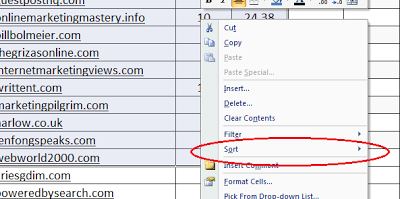
You then have to select “custom sort” then order the sort
from highest to lowest then start removing the links that’s lower than PR2 and
DA 30.
Hint: You don’t always
have to do this. Some sites may have lower stats because they are still new and
the flip side is also true. Not all sites with high PR and DA are quality
sites. These two metrics can be easily manipulated especially by spammers.
What I do is just my
preference to start linking to sites with relatively better stats.
7.) Look for the webmaster’s contact
information
Now that you already have the link profile that you want to
reach out to, you just have to go to the sites and look for the webmaster’s
contact information.
Hint: This task is
made easy if you have the Buzzstream which is a paid tool. But since I want to
share the free method of doing this to help other marketers who don’t have as
much budget, I won’t delve into Buzzstream.
8.) Be sure to check out the site’s guest
posting guidelines and adhere to it when writing the articles.
Hint: If you’re having
a hard time thinking of a title, then you can go to
portent.com/tools/title-maker/
Tips for writing the
outreach email:
1.) Try to be casual and make the email sound a
bit personal.
Instead of saying “Hello admin”, use “Hi
(and their name)” instead.
The “Hello admin” route is almost a sure
fire way of not being considered for the guest post so don’t even try it. You
be better off only saying “Hi” if you can’t find the contact person’s name.
2.) Don’t talk about yourself but instead, talk
about how they can benefit from you.
Compare this… “I am an expert writer” vs. “Your
community will find the nicely written article helpful”.
See the difference? They don’t care who you
are and what you do. In their mind they have the “what’s in it for us”
mentality so be sure to focus on how they can benefit from your post.
3.) Emphasize that you’ve added some multimedia
elements to help in increasing the article's readability
Now it can be just plain images, videos,
infographics, memes, etc. Just be sure to add some and let them know about it.
That way they can appreciate your efforts.
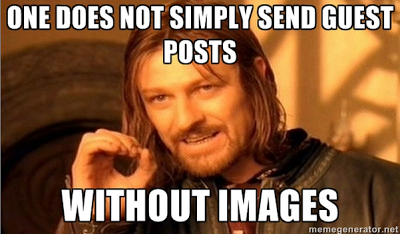
Hooray! It’s done!
At this point, if your article is well written, they would
either post it or let you know if there’s anything else that they need.
Just be sure that the links that your articles are pointing
to on your site is relevant to the topic. That way you won’t be thought of as
spamming.
Once you’ve built these links to your site, you’ll start
seeing traffic, brand recognition, and even see the link juice helping with
your site’s ranking. The more quality links you create, the better results
you’ll get.
With all these three elements working for you, selling your
book should be a lot easier.
Speak your mind!
If you have any ideas, questions or any suggestions about
the topic, I urge you to share it in the comments section below. I hope to hear
from you soon. Cheers!
About the author:

Adam Prattler aims to build a better internet society through his advocacy towards
ethical guest blogging. Join him at Postme and be with bloggers and authors who share the same passion.








Published on August 29, 2013 21:04
August 27, 2013
When Would An Author Rather Be Naked?
No matter how much blood, sweat, and tears go into your book, it's only natural for some authors to feel apprehensive about taking the final step: publication.

On the one hand, authors want readers. On the other hand, once the book is out there there's no way to know how readers will react. The hope is that they will love your book; the reality is not everyone will be a fan.
Author Christina George shares her thoughts on being published as the second book in her series, The Publicist, nears publication: http://www.thepublicistnovel.com/id-rather-be-naked
Free free to share your thoughts, and if you have any questions about book publicity, book publicists, publishing, etc., check out Christina's new group on Goodreads, Ask The Publicist About The Book Publishing Industry, http://www.goodreads.com/group/show/112218-ask-the-publicist-about-the-book-publishing-industry.








Published on August 27, 2013 18:07
August 25, 2013
4 Ways to Sell eBooks Directly to Readers
This chapter explains how to sell your eBook directly to readers without using an online reseller such as Amazon, Apple, Barnes & Noble, Google Play, or Kobo. (We cover selling your printed book directly to readers in chapter 16: "How to Use Print-on-Demand Services.") Readers can get your book and revisions immediately, and you can make as much money as possible on each sale.
However, this is too perfect a picture, so keep two factors in mind. First, somehow you need to get the eBook to your customers and their money to you. This can entail website hosting, fulfillment, payment processing, shipping, and customer service.

Second, this method only works if you have the ability to expose your readers to your offering. While people might stumble upon your book on Amazon, iBookstore, Nook, Google Play, and Kobo because of internal recommendation engines and large amounts of traffic, this isn't going to happen with this type of sale.
Gumroad
Gumroad https://gumroad.com/ charges $0.25 per download plus 5 percent of the sale for hosting and selling your file. For example, if you sell a PDF for $3, Gumroad keeps $0.40 ($0.25 + 5 percent of $3) and you'd get $2.60. This is more than you'd get from Kindle Direct Publishing for the same transaction. Gumroad also offers a "$0+" option. This means that people can pay whatever they want to-including nothing.
I used Gumroad to distribute a PDF of What the Plus! Unfortunately, I didn't track results when I varied the price from $2.99 to as low as "pay what you want." Over the course of a month, 26,717 people clicked on the link, and 1,632 people downloaded it.
Most people paid $0, but the donations amounted to $803.23, so the average amount paid was approximately $0.50 per copy. This was four months after the introduction of the book. By that time, I had given away approximately 15,000 copies and sold 15,000 copies.
People cannot pay with PayPal because Gumroad only accepts credit cards. Also, Gumroad asks for a minimal amount of personal information, so it cannot provide information about where your customers live. Someday you may need this information to charge sales tax or value-added tax for digital content.
Gumroad requires a preexisting and loyal audience that will click on a link that you provide. As a first-time author, this may be difficult, but you'll learn how to build your "platform" in the next section of the book, "Entrepreneur." If you can make this work, there are two big benefits: retention of more of the selling price and access to the e-mail addresses of everyone who has bought the file.
E-Junkie
E-Junkie http://www.e-junkie.com/ is another way to sell your book directly. Unlike Gumroad's per-copy flat fee and percentage, E-Junkie charges according to the number of files and storage space that you use. The number of downloads is unlimited.
A collection of ten files totaling less than fifty megabytes costs $5 per month. Therefore, if you had one book that is less than fifty megabytes (which is a huge size for a book), you'd only pay $5 per month, and you could sell an unlimited number of copies.
Unlike Gumroad, customers can use PayPal, Google Checkout, TrialPay, and Authorize.net but not credit cards. Finally, also unlike Gumroad, E-Junkie can calculate sales tax and VAT charges because it knows where your customers reside.
ClickBank
ClickBank http://www.clickbank.com/ is a third way to sell ebooks directly. You create an account, upload your file, price it, and sell it. There is a $49.95 activation fee to get started. Customers can use credit cards or PayPal.
A key difference between ClickBank and the other two services is ClickBank's affiliate program. The scenario ClickBank paints is that people discover great books in the ClickBank marketplace. Then they join the ClickBank affiliate program, get an affiliate link to their favorite books, and promote the link on their blog and through social media.
The company says that it has 100,000 affiliates in 200 countries. It claims to have paid more than $1.8 billion to affiliates and vendors (the people who upload files) and to process 30,000 transactions per day.
The revenue split with ClickBank is different from the other direct-sales sites. ClickBank operates on a wholesale price/retail price model, which means you set a wholesale price (the price at which ClickBank and other affiliates buy the book from you) and a retail price (the price customers see and pay). Your revenue is the wholesale price, since you are selling to ClickBank, and they are the seller of record to customers.
Ganxy
Ganxy http://get.ganxy.com/ is an interesting start-up in this segment. It enables you create a "showcase" for your eBook and sell it in EPUB, MOBI, and PDF format. Ganxy provides payment functionality, file hosting, and customer service.
Ganxy charges 10 percent of net sales, where net sales is the selling price of the eBook less a payment-processing fee. Think of it as a website like Gumroad, E-Junkie, and ClickBank that is dedicated to selling eBooks.
Caveats
If you can convince people to buy your book from these services, you can make more money per book. Nathan Barry's App Design Handbook http://nathanbarry.com/app-design-handbook/ is an example. Barry has a concentrated market of app programmers, and these programmers are willing to pay his book's price of $39.
For these programmers, the book isn't a $2.99 Gothic-romance whim. Designing apps is their livelihood, so a $39 price point for a book that can help them succeed isn't a problem. Barry makes approximately $38.20 per book, so if he sold 2,000 copies, he could buy a Porsche.
On the other hand, online eBook resellers such as Amazon and Apple pay less per copy, but they may sell more copies. Also, direct sales do not count toward sales rankings for bestseller lists, and books on these lists tend to sell more because they are visible.
If your customers are not price sensitive and you have a way to reach them, then selling direct can work. If these conditions do not exist, then it may be better to make less money per copy but sell more copies using online resellers and bookstores.
PayPal
If you're wondering about using PayPal to sell eBooks, it's not applicable to most self-publishers because this would require creating a website where your readers have an account, and you control access to your eBook's file. Essentially, you'd have to become your own E-Junkie and manage an ecommerce site.
PayPal provides payment collection, and when someone pays, it tells your website to grant access-for example, if someone buys more weapons in an online game. Credit cards such as MasterCard and Visa work in similar ways. However, these companies do not act as your store by hosting your eBook and selling it.
So your customers can pay with PayPal and credit cards, but on Gumroad, E-Junkie, and ClickBank, not directly to you.

Guy Kawasaki has written 12 books, 10 of which were traditionally published. His newest book is APE: Author, Publisher, Entrepreneur - How to Publish a Book, which helps people understand how and why to self-publish.
APE: Author, Publisher, Entrepreneur - How to Publish a Book, by Guy Kawasaki and Shawn Welch, is available as an eBook ($9.99) and in paperback ($24.99). Visit http://apethebook.com/








Published on August 25, 2013 20:11
August 23, 2013
Top 5 Best Social Media to Use for Social Marketing If You’re An Author
Authors nowadays need not even rely on traditional marketing media to get word on their works out to the world. Today, social media networks and websites can serve as superb platforms for that purpose, allowing authors, artists, and other creative minds to bring their talents and products to the public’s attention through social networking and direct interaction. Below we list some of the best social media websites that you can use for this purpose and even give you some tips that can help you make the most of each option.
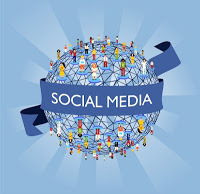
1. Facebook – No surprise here. Nearly everyone is already on this website, and that includes companies and other entities more concerned with business than “pure” personal socialization. Authors can get a lot out of Facebook since it allows for a variety of media on its pages. Consider using your Facebook account to post visual updates on your book, for instance: photos of key events in its genesis or of things related to its contents can generate more interest than a dry snippet of text. You can also start up promotional contests here that will get word out about your work.
2. LinkedIn – This is a great resource for those with books that deal specifically with something of interest to the business world. LinkedIn’s demographic has a higher average household income per user than most other sites—Facebook and Twitter included—and most people logging into it do so for rather more serious business than your average social networking site. Business tends to be the big topic here, which is why authors with business-related books can do some fine promotion on it. To get the most out of LinkedIn, join groups relevant to your topic and spruce up your profile with links to your site or products.
3. YouTube – This is undoubtedly one of the best social media marketing resources online: YouTube is not only interactive (people react to videos, create video responses, link them to others, comment on them, etc.) but also easy to use, and in some cases, you might not even need your own video camera to use its marketing potential. If you know people who review or talk about stuff related to your topic or book on their channels, you can simply send them a message and invite them to talk about your book in exchange for something like a free copy. This way, you get videos talking about you out to the right audience—which is provided for you straightaway in this method.
4. Twitter – This just has to be mentioned if you are marketing something with social media. Twitter might not allow you to put out a lot of content per tweet, but short and sweet can actually be a good thing where marketing is concerned: it condenses information into just the most important, most scintillating core of the idea and tantalizes the reader into wanting more. Just remember, though: when you use Twitter to market your book, steer clear of direct sales pitches (or, at least, of using them alone). You should try to intrigue people before even directing them to a sales page, and the best way to do that is to tweet information or useful ideas from the book—as opposed to ones that are simply about it.
5. Google+ - Of course, no list on great social media sites for marketing would be complete absent Google+. Google+ can function much like Facebook—albeit with even wider integration in your other web activities—and you can promote your books with it by joining relevant communities and circles as well as participating in events that may be concerned with your topic. Communities, in particular, can be very helpful, as they let you get in touch with those who think the same way or are interested in the same things: the ideal readership for your new work.
About the author: Ashley Hartnett is a consultant in social media marketing and, more broadly, Internet marketing. She occasionally gives talks on the topic, and is currently involved in marketing a number of sites and online brands, including Morbie.com.








Published on August 23, 2013 05:57
August 20, 2013
How Online Reviews Can Increase Book Sales
Authors
who are trying to get the word out about their book should embrace online reviews. Online reviews are a form of word of mouth
marketing and can hold a great deal of value to those who are searching for new
books to read. Do not fear negative reviews; instead focus
on the positive effects that online reviews can bring along with the possibility of book sales.
Online Reviews Carry as Much Weight
as Personal Recommendations
In 2005 a Yale School
of Management study revealed that online reviews increase book sales. Now, many
years later, more people are online to read and write reviews, so the influence
of online reviews has grown along with Internet use. In fact, a 2009
study from Saurage Research shows 84% of
US shoppers look to reviews before they decide to buy.
A 2011 survey of online shoppers showed that 69% trust online reviews just as much as a
personal recommendation from someone they know. However, even though they do
not know the person who wrote the review, shoppers trust online reviews much
more than advertising or marketing that comes from a company. An Econsultancy report reveals that less than 10% of
consumers trust what companies say about themselves.
Reviews Do Not Have to be
100% Positive
Do not
worry if some reviews are negative. You can’t please all the people all the
time, right? Plus, studies have shown that when online reviews are all
positive, people mistrust the review process and assume that the reviews might
be made up since they understand that not everyone can be happy with
everything. Therefore, some negative reviews in the mix lend credibility to the
reviews on any particular site, whether it is your book page on Amazon,
a book seller's site, your own site, or another review site.
Reviews Can Add Insight as to What
Your Readers Like
You should
also see reviews as a learning process and a peek into the minds of
your readers. This is especially helpful if you have an ongoing story across
multiple books or a recurring character. Reviews can serve as research into
what your readers want to see happen. This type of input can be very valuable, helping to keep your readers happy and buying future books.
Strategies to Increase Online
Reviews for Your Books
Optimize your review page on each of the book seller and review sites. Fill in all of the information they ask for in the profile sections and claim them as your official page.
Ask and you shall receive! Reviews from your social media fans and followers and your email list are likely to be positive and a great addition when building up the review sites. Make your request as personal as possible and your readers will probably be happy to oblige.
Write reviews for books similar to yours. New readers searching through reviews look at similar book reviews. If you leave a review about other books and sign them with your name “Author of Name of Book,” people reading that review may check out your book.
When you find avid readers in your genre, contact them to see if they would write an online review of your book.
Seek review bloggers and offer them a review copy. They tend have a large following and a review can get you a lot of buzz and possibly more reviews.
About the author: Richard Larson is author and
Brand Manager for GoPromotional’s
Umbrellas. He enjoys writing about marketing and business topics.








Published on August 20, 2013 20:11
August 18, 2013
How to Sell Your eBook Through Amazon
Kindle Direct Publishing is the Amazon self-publishing service for eBooks. It is the gorilla in the market and can account for most of your sales. Amazon owns this market. Let's face it, Amazon equals online books the way Volvo equals safety and Starbucks equals coffee.
There's a wide selection of Kindle devices from Amazon as well as a Kindle app for Macintosh, Windows, BlackBerry, Android, and iOS devices. People can also read their Kindle books using web browsers. Kindle Direct Publishing is the path of least complexity, most sales, and greatest visibility for most self-published authors.

Getting started: If you have written a novel or a nonfiction book with no tables, graphics, and bulleted or numbered lists, you're in good shape with Kindle Direct Publishing. Write your book in Word, use Word's styles, design a cover (or have one designed), upload it at Kindle Direct Publishing, https://kdp.amazon.com/self-publishing/signin and one to two days later, you're in business.
We want to ensure that you completely understand Kindle Direct Publishing's royalty deals. There are two rates: 70 percent and 35 percent. The 70 percent rate has these caveats:
* You must price your book between $2.99 and $9.99 in the United States. The range varies in other countries.
* Kindle Direct Publishing deducts a delivery charge from your royalty based on the file size of your book. In the United States, for example, the charge is $0.15 per megabyte. This is not a big deal if you're publishing a pure-text novel (approximately one megabyte or $0.15, unless you're a descendant of Tolstoy).
* Delivery charges in other countries are: United Kingdom: 0.10 Pounds per megabyte; Germany, France, Spain, and Italy: 0.12 Euro per megabyte; India: $0.12 (US) per megabyte.
* Kindle Direct Publishing matches prices from other resellers, and your royalty is calculated on the lower price.
The 35 percent rate, while obviously lower, has some advantages:
* There is no delivery charge.
* Kindle Direct Publishing matches prices of other resellers but continues to pay royalty based on the "digital list price" not what customers paid unless the eBook was free.
However, the size of your file determines the price range that you can use under the 35 percent plan:
* Less than or equal to three megabytes: $0.99-$200
* Greater than three megabytes but less than ten megabytes: $1-$200
* Ten megabytes or more: $2.99-$200
The 70 percent choice is not a no-brainer. You need to consider the size of your file and the delivery charge it will incur, as well as the likelihood that other resellers will heavily discount it. Kindle Direct Publishing provides an up-to-date explanation on its website https://kdp.amazon.com/self-publishing/help?topicId=A29FL26OKE7R7B.
Fine print:
* Kindle Direct Publishing compresses your file. For example, What the Plus! is a fifty-four-megabyte Word file with more than one hundred pictures. Adobe InDesign turned it into a twenty-two-megabyte MOBI file. Kindle Direct Publishing compressed this file to 3.85 megabytes, so it cost approximately $0.58 to deliver each copy under the 70 percent royalty deal. (The website will tell you the delivery file size and cost estimate when you set your prices).
* Lossless Word conversion for complex books is challenging. To achieve the best possible conversion, you should upload books to Kindle Direct Publishing in the MOBI file format. Conversion to the MOBI file format from Word is covered in chapter 13: "How to Convert Your File."
* Kindle Direct Publishing monitors the price of your book on other reseller sites and matches the price automatically. You have no choice in the matter, so if one of your other resellers is running a special, Kindle Direct Publishing will immediately match the price, and you will earn your normal royalty percentage of the lower price.

Guy Kawasaki has written 12 books, 10 of which were traditionally published. His newest book is APE: Author, Publisher, Entrepreneur - How to Publish a Book, which helps people understand how and why to self-publish.
APE: Author, Publisher, Entrepreneur - How to Publish a Book, by Guy Kawasaki and Shawn Welch, is available as an eBook ($9.99) and in paperback ($24.99). Visit http://apethebook.com/








Published on August 18, 2013 19:01
August 15, 2013
3 Online Marketing Strategies for Authors
Establishing your
name as an author can be a difficult thing to do in such a competitive
industry. Whether you are writing a novel about fantasy fiction or a
professional writing as a financial
advisor it is essential to
get a decent marketing strategy in line. Since more and more of our lives are
based on the Internet, it is essential to create a digital marketing strategy
in order to enhance your profile online. Marketing strategies bounce off each other
and your offline marketing campaigns can complement your digital strategies. We
have put together a few pointers to help you establish your name as an author
on the World Wide Web that will reflect in more people talking about you and in
turn drive sales to your books.

Create a Website with a Blog
Your website should
be your online home as an author. This is where fans can find out more about
you, your professional career and the personal information you wish to share.
The website should provide links to your current work as well as archived work.
You can use Wordpress or Blogger to create a free blog, so all you have to
dedicate is your time. Visitors who enter the site should be able to sign up to
a newsletter or email from you, this will build a strong continuous
relationship between you and your readers. By capturing email addresses from
your readers you can then upkeep the relationship by running contests,
giveaways and increasing your overall interactions with fans. A great way to
entice new readers and fans is to offer a sneak peak of new books on your site.
If they like what they see, they are likely to come back for more and even
purchase in store.
Establish Yourself on Social Media
Creating a Facebook fan page for
your book is a great platform and powerful opportunity to increase the
visibility of the title in search engines as Google indexes fan pages. By
having links to your website and other social media channels you are keeping a
constant flow between your online channels. The profile is essentially an ad so
make sure that it is great. A high quality picture and enticing information are
essential. You could even include iFrames, custom designed tabs that allow you
to sell directly from Facebook. Use Twitter account with your own name as the
main point of conversation between you and your fans. Social media is not a one
way broadcast so make sure to dedicate time to respond to fans comments and
queries. You can even invite Twitter users back to your website for an even
deeper conversation and build the author/ reader relationship further.
Online Advertising
Online advertising
is one of the most effective ways of promoting your book online. You can create
online advertising on Google, Bing and Yahoo to suit any budget. Once you
analyse your target audience you can easily develop strategies to entice people
that will potentially buy your book. Make sure to continuously monitor your
campaigns so that you can adjust them for optimum results. Use Facebook’s
sponsored stories to attract an even wider Facebook fan base. Facebook ads can
also be created to direct your fans back to your original website.
There is incredible
scope online to spread your name as an author and your latest releases. By
getting people talking online, they will inevitably be talking about you at
ground level too. As conversation sparks you will notice an increase in your
online fan base and your off line sales. Win win! Work hard and you will reap
the rewards.
About the author: Iveta Ivanova is a web and technology
enthusiast who lives in Dublin. She has lots of interests such as business, SEO,
digital marketing and social media. She writes on behalf of www.fkinternational.com.








Published on August 15, 2013 20:52
August 13, 2013
6 Key Book Marketing Strategies for Authors
Becoming a successful author requires plenty of hard work, dedication and a commitment to perfecting your craft. Although you may spend plenty of time on editing and updating your latest novel, knowing how to properly market and advertise your book is also essential to get the most publicity with anything you have written. The more you understand about effectively marketing books and sharing your work, the easier it is to make a splash in the publishing world regardless of the genre you represent.

Covers Matter
Although it is common knowledge to never "judge a book by its cover", the sad truth is that we often judge most products and merchandise by their appearance before reviewing them or learning about their quality. Designing a professional book cover is essential when you want to make a real impact in the publishing world. Working together with a professional graphic or print designer can help you to reach any specific audience whether you are targeting teenagers or a set demographic of adults. If working with a designer sounds daunting (or expensive) you might just be missing the right tools. Compare designers based on pricing and past work on fiverr.com and www.iwilldesignyou.com. Each site operates as a marketplace, which means prices are low but you can still shop around to pick a high quality designer to work with on your cover.
Launch a Website
Okay, okay. So you've already heard this tip 1,000 times. What you want to know is, "How?" For the majority of us (with no coding experience) the fastest, easiest way to get a professional looking website up and running is to use an inexpensive site builder like Squarespace.com or Wix.com. Each site has several professionally-designed, easy-to-customize templates available to start your site design with. Customizing a template is as easy as dragging and dropping each element, image, or chunk of text to exactly where you want it to be.
If you do happen to have some HTML and CSS skills under your belt, a more advanced website builder like GoZesty.com will give you more access to customize how your site looks and operates. The team at GoZesty also offers incredible support and training for using their toolset to build your dream author site.
Create a Newsletter
Having your own newsletter is a great way to keep in touch with your genuine fans and followers. Those who purchase your books or publications can keep up with your latest releases by subscribing to a newsletter. When you launch a newsletter you can instantly update your followers to keep them interested in the work you are doing or the publications you are currently promoting. Stuck on what to write to keep your newsletter followers interested? Here are three ways to set some dynamite to that writers block:
Start by following the newsletters of your favorite contemporary authors. Watch what they send out and keep track of which posts seem to generate the most buzz/shares/comments across social networks and on the author's blog.
Answer fan questions. If you've published anything before, there's most likely a standard set of questions you know you'll hear at each book signing, publishing party, etc. While these questions might seem like a nuisance, they're actually a blessing - a source of content inspiration! If enough people are asking the same questions, whether they be about character development your favorite writing utensil, that usually means there are even more people out there with the same question. On top of that, featuring reader questions encourages your audience to engage with your newsletter and usually ends up leading them to share it with friends when they are lucky enough to have their question featured by you.
Comment on the competition. Write reviews on books similar to your genre. Fight the fear that it'll lead your fans to a competing author's book. Establishing yourself as an authority in your genre will keep readers coming back to you as a versatile source of insight into their favorite reading genre. There is an overabundance of self-promoting authors in the industry. A rare few share knowledge, critiques, and recommendations that benefit an audience.
Ask for Reviews From Other Bloggers
Ask for reviews of your books from other writers, bloggers and individuals who are running popular and relevant websites online. Sending free copies of your books to those who have agreed to write a review in exchange is a great way to build your professional reputation while also increasing the amount of exposure you receive online. You can also work with other authors who represent the same genre as you to help with promoting one another within your blogs, social media accounts and with your own official website.
Collaborate With Others
Collaborate with other authors to write new books, publications and newsletters. Ask writers with a larger audience than yours if they'd write the forward or prologue in your next book. The more you collaborate with other individuals who are working in the same industry, the easier it is to build your professional reputation and the amount of credibility you have.
Put Social Media to Use
Establishing your presence as a resource on social media is a great way to market your books and other publications. Set up social media accounts on Facebook, Twitter, Instagram, Pinterest and even Vine, then share your partner-author's works, blog posts, etc. to help with boosting your exposure while gaining followers and page views on your site and other accounts. The more of a resource you are on social media, the easier it is to reach any intended audience. Social media is free to use and allows you to target specific demographics while also reaching a much wider audience than when you are utilizing traditional advertising and marketing tools or strategies.
Publishing and marketing your writing can be tricky with all the new tools and tricks brewing on the Internet. Take your time, build an audience that cares, interact with them, and offer your knowledge as a resource and you'll soon find new readers, followers and fans.
About the Author: Daniel Horning works and writes for HireAHelper, a move help comparison tool.








Published on August 13, 2013 19:20
August 11, 2013
5 Issues That Affect How You Should Price Your Book

Pricing Variables
There are five major variables that affect the price of your book. Here is a discussion of each to help you decide on a strategy.
Costs. There are two kinds of costs: preparation and production. Preparation costs include such processes as design, editing, and layout. You might pay them only once, but nonetheless, you need to recoup them.
Production costs refer to how much it costs to make copies. If you're publishing only an eBook, the cost per unit is almost zero. If you're printing your book, you'll incur hard costs such as paper, printing, binding, and shipping.
Economic conditions. How is the job market for your target customers? While your book's price is probably one or two Starbucks cappuccinos, economic conditions matter to people and influence their buying decisions.
Brand. How strong is your brand? How many people know about you? Simplifying the issue, here are the most common conditions:
* First-time author without an established base of readers. Implication: charge less.
* First-time author with an established base of fans and high visibility. Implication: charge more.
* Repeat author with a proven record and established base of readers. Implication: charge even more.
Competition. How much does the competition charge for books in your genre? You cannot charge the same price as well-established authors such as J. K. Rowling. You should look at authors who are at the same stage as you.
Goals. What are your goals for your book? Here are the most common:
* Maximize short-term (six months to a year) revenue. Implication: charge more.
* Maximize long-term (a year or more) revenue. Implication: charge less.
* Establish yourself as a sector expert. Implication: charge less.
* Build a base of readers for future works. Implication: charge less.
* Spread your ideas. Implication: charge less.
Pricing philosophy. What's your pricing philosophy? First, let's dismiss "I worked hard on this book, so it's worth lots of money." It doesn't matter how hard you work. What matters is what people are willing to pay. These are the common pricing philosophies:
* High price connotes high quality. Low price connotes low quality. Implication: charge more.
* High price connotes cluelessness. Low price connotes awareness. Implication: charge less.
* High price connotes greed. Low price connotes empathy. Implication: charge less.
* The relationship between price and quality is random. Implication: take your best shot and change the price if it's not working.

Guy Kawasaki has written 12 books, 10 of which were traditionally published. His newest book is APE: Author, Publisher, Entrepreneur - How to Publish a Book, which helps people understand how and why to self-publish.
APE: Author, Publisher, Entrepreneur - How to Publish a Book, by Guy Kawasaki and Shawn Welch, is available as an eBook ($9.99) and in paperback ($24.99). Visit http://apethebook.com/








Published on August 11, 2013 18:52



